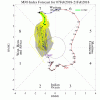packfan98
Moderator
The GEFS can’t even get the 10-day right, it’s not going to accurately predict the 11-16 mean heights for the NH.
And sure enough the model corrected the trough.
The positive thing I do see out of that 11-16 day mean in the quote is a stout -AO, which models have also caught onto the last 1-2 or so
The SOI has really tanked as well. Many signs point to a window of opportunity. Nobody seems to have much hope because it's getting late into our winter season and the models just don't seem show anything compared to the decent look of the teleconnections. Hopefully, the operational models will catch up and start showing something better over the next week of runs.











